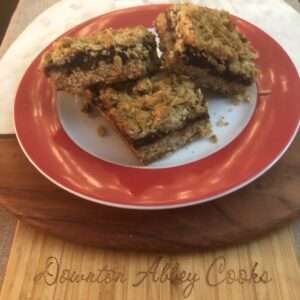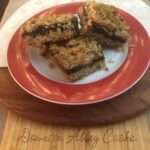Few desserts capture the essence of Canadian prairie history quite like the humble matrimonial bar. With its distinctive date filling sandwiched between buttery oat layers, this beloved treat has graced community cookbooks, church potlucks, and family gatherings for generations. But what’s the story behind this curiously named confection?
Origins and Etymology
The history of the matrimonial bar is deeply intertwined with Canada’s prairie provinces, particularly Manitoba, Saskatchewan, and Alberta. Dating back to the early 1900s, these bars emerged when dates became increasingly available in Western Canada through improved trade routes and preservation methods.
The name “matrimonial” has sparked numerous theories among food historians. One popular explanation suggests that the bars represent marriage: the sweet, sticky date filling holding together two complementary layers, much like the bonds of matrimony. Others propose that these bars were a standard fixture at wedding celebrations due to their ability to be made in advance and transported well.
The Rise of a Prairie Staple
During the Great Depression, matrimonial bars gained prominence as a practical dessert. While considered exotic, dates were relatively affordable and provided natural sweetness when sugar was expensive. The oat layers utilized readily available prairie grains, making these bars an economical choice for farm families.
The treat’s popularity surged in the 1930s and 1940s, appearing in numerous community cookbooks and becoming a staple at social gatherings. The T. Eaton Company’s famous cookbook, published in the 1930s, included a version many consider the definitive recipe.
Cultural Significance
Matrimonial bars represent more than just a dessert – they embody the prairie spirit of resourcefulness and community. Farm women would often exchange recipes and variations, leading to subtle regional differences across the provinces. Some families added nuts to the crumble, while others experimented with different dried fruits.
Regional Variations and Names
While widely known as matrimonial bars in Canada, similar desserts appear under different names across North America. They’re sometimes called date squares or date slices in parts of the United States. Maritime Canada often refers to them as date crumbles, though the preparation remains similar.
Modern Revival
Today, matrimonial bars are experiencing a renaissance due to the growing interest in heritage recipes and regional Canadian cuisine. Modern food bloggers and chefs are rediscovering these bars, appreciating their simple ingredients and rich cultural history. They’re trendy during the holiday season and are a favourite at community events.
Legacy and Impact
The enduring popularity of matrimonial bars speaks to their perfect balance of taste, practicality, and nostalgia. They represent a time when desserts were made with simple, available ingredients and shared among neighbours. This legacy continues to influence Canadian baking traditions, making these bars a significant piece of prairie food history.
The humble matrimonial bar is a testament to the ingenuity of prairie bakers and the enduring appeal of well-crafted, simple desserts. As new generations discover these historic treats, they ensure that this piece of Canadian culinary heritage will continue to be celebrated and enjoyed for years.
Matrimonial Bars /Date Squares
Equipment
- 1 8 inch square baking pan
Ingredients
Filling
- 2 1/2 cups Medjool dates pitted and chopped 425 g
- 1 cup water 250 ml
- 2 tbsp lemon juice 30 ml
- 2 tbsp brown sugar
- 1/2 tsp baking soda
Topping
- 1 3/4 cups quick or large flake oats 175 g
- 1 cup unbleached all-purpose flour 150 g
- 3/4 cup brown sugar 160 g
- 1/4 tsp baking powder
- 3/4 cup unsalted butter softened 170 g
Instructions
- Preheat the oven to 350 °F (180 °C). 8-inch square baking dish, preparing with non stick glaze*
Filling
- Place dates water, lemon juice, and brown sugar in a saucepan bring to a boil. Turn down the heat and add the baking soda, stirring with a wooden spoon for 5 minutes or until the dates have fallen apart. Take the saucepan off the stove and let cool.
Topping
- Combine the oats, flour, brown sugar, and baking powder in a large bowl and then add the butter, stirring to combine.
- Spread half the topping in the bottom of the baking pan, pressing firmly into the corners. Spread the filling on top of the base layer. Cover with the remaining topping and press lightly.
- Bake for 40 minutes or until the topping is golden brown. Let cool on a wire rack until completely cooled. Cut into 16 squares.

